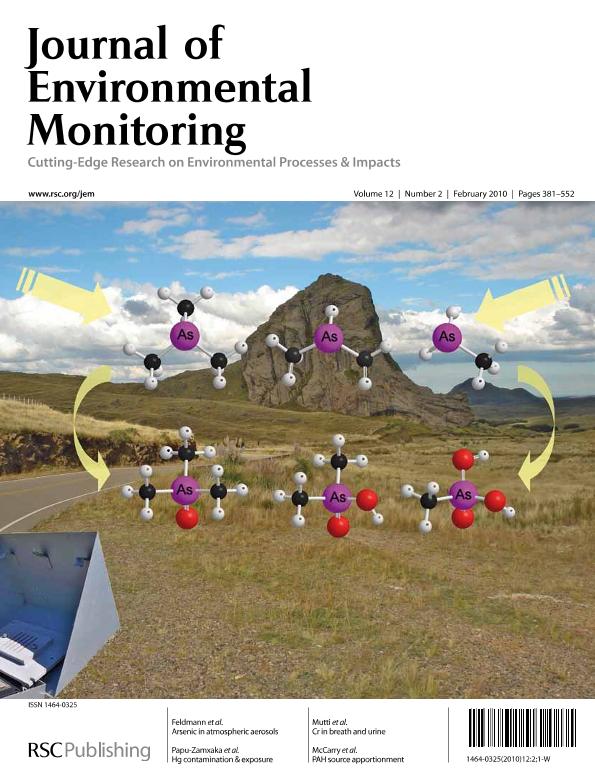Artículo
Atmospheric stability of arsines and the determination of their oxidative
Jakob, Ronit; Roth, Anja; Haas, Karsten; Krupp, Eva M.; Raab, Andrea; Smichowski, Patricia Nora ; Gomez, Dario Gustavo
; Gomez, Dario Gustavo ; Feldmann, Jörg
; Feldmann, Jörg
 ; Gomez, Dario Gustavo
; Gomez, Dario Gustavo ; Feldmann, Jörg
; Feldmann, Jörg
Fecha de publicación:
02/2010
Editorial:
Royal Society of Chemistry
Revista:
Journal Of Environmental Monitoring
ISSN:
1464-0325
Idioma:
Inglés
Tipo de recurso:
Artículo publicado
Clasificación temática:
Resumen
Biovolatilisation of arsenic as their arsines in the form of AsH 3, and mono-, di and trimethylarsine has often been determined under laboratory conditions. Although environmental point sources such as landfill sites or hot springs have been characterised, only limited knowledge is available on how widespread the formation of volatile methylated arsenic compounds are in the environment. Here we studied the atmospheric stability of the different arsines and quantified their oxidation products in atmospheric particulate matter (PM10) in two locations in Argentina. The atmospheric half-life of the arsines range from 19 weeks for AsH3 to 2 d for trimethylarsine (TMAs) at 20 °C in the dark, while during simulated daytime conditions the stability is reduced for all arsines and in particular for the methylated arsines by three orders of magnitude which suggests that TMAs can only be dispersed at night. At both locations the arsenic concentration was in all samples below 1 ng As m-3, which is considered as rural background for arsenic. The oxidation products, i.e. methylarsonate (MA), dimethylarsinate (DMA) and trimethylarsine oxide (TMAO) were identified by using HPLC-ICP-MS/ES-MS in more than 90% of the 49 PM10 samples taken from 8 sampling points at the two geographically different locations. TMAO was the predominate organoarsenicals in both locations (66 and 69%, respectively) while DMA was determined to be between 13 and 19% of all organoarsenicals at the two locations. The concentration of the organoarsenicals ranged from 4 to 60 pg As as TMAO m-3, while the maximum concentration for DMA and MA were 16 and 6 pg As m-3, respectively. No difference in terms of the concentration or distribution of the organoarsenicals in the PM10 samples was identified as significant. Since the two locations were different in climate and industrial impact and sampled in different seasons, these data suggest that methylated arsenicals do occur as background chemicals in the environment. Due to the low atmospheric stability of the methylated arsines, it is suggested that biovolatilization of arsenic as methylated arsines is a widespread phenomenon. More studies however are necessary to identify the major sources and determine the flux of the volatilization process in order to determine whether or not the process has environmental significance.
Palabras clave:
ARSENIC
,
ATMOSPHERIC AEROSOLS
,
BIOVOLATILIZATION
,
SPECIATION
Archivos asociados
Licencia
Identificadores
Colecciones
Articulos(SEDE CENTRAL)
Articulos de SEDE CENTRAL
Articulos de SEDE CENTRAL
Citación
Jakob, Ronit; Roth, Anja; Haas, Karsten; Krupp, Eva M.; Raab, Andrea; et al.; Atmospheric stability of arsines and the determination of their oxidative; Royal Society of Chemistry; Journal Of Environmental Monitoring; 12; 2; 2-2010; 409-416
Compartir
Altmétricas



